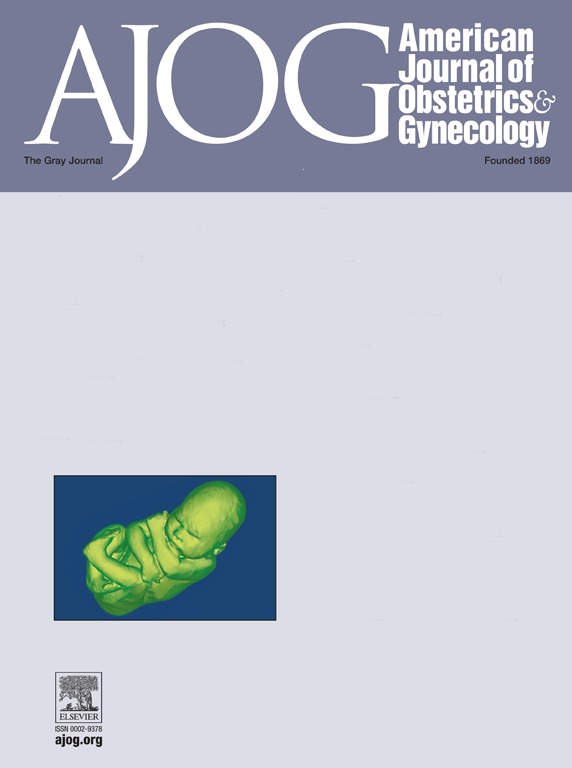Vasa previa in singleton pregnancies: diagnosis and clinical management based on an international expert consensus
IF 8.7
1区 医学
Q1 OBSTETRICS & GYNECOLOGY
引用次数: 0
Abstract
Background
There are limited data to guide the diagnosis and management of vasa previa. Currently, what is known is largely based on case reports or series and cohort studies.
Objective
This study aimed to systematically collect and classify expert opinions and achieve consensus on the diagnosis and clinical management of vasa previa using focus group discussions and a Delphi technique.
Study Design
A 4-round focus group discussion and a 3-round Delphi survey of an international panel of experts on vasa previa were conducted. Experts were selected on the basis of their publication record on vasa previa. First, we convened a focus group discussion panel of 20 experts and agreed on which issues were unresolved in the diagnosis and management of vasa previa. A 3-round anonymous electronic survey was then sent to the full expert panel. Survey questions were presented on the diagnosis and management of vasa previa, which the experts were asked to rate on a 5-point Likert scale (from “strongly disagree”=1 to “strongly agree”=5). Consensus was defined as a median score of 5. Following responses to each round, any statements that had median scores of ≤3 were deemed to have had no consensus and were excluded. Statements with a median score of 4 were revised and re-presented to the experts in the next round. Consensus and nonconsensus statements were then aggregated.
Results
A total of 68 international experts were invited to participate in the study, of which 57 participated. Experts were from 13 countries on 5 continents and have contributed to >80% of published cohort studies on vasa previa, as well as national and international society guidelines. Completion rates were 84%, 93%, and 91% for the first, second, and third rounds, respectively, and 71% completed all 3 rounds. The panel reached a consensus on 26 statements regarding the diagnosis and key points of management of vasa previa, including the following: (1) although there is no agreement on the distance between the fetal vessels and the cervical internal os to define vasa previa, the definition should not be limited to a 2-cm distance; (2) all pregnancies should be screened for vasa previa with routine examination for placental cord insertion and a color Doppler sweep of the region over the cervix at the second-trimester anatomy scan; (3) when a low-lying placenta or placenta previa is found in the second trimester, a transvaginal ultrasound with Doppler should be performed at approximately 32 weeks to rule out vasa previa; (4) outpatient management of asymptomatic patients without risk factors for preterm birth is reasonable; (5) asymptomatic patients with vasa previa should be delivered by scheduled cesarean delivery between 35 and 37 weeks of gestation; and (6) there was no agreement on routine hospitalization, avoidance of intercourse, or use of 3-dimensional ultrasound for diagnosis of vasa previa.
Conclusion
Through focus group discussion and a Delphi process, an international expert panel reached consensus on the definition, screening, clinical management, and timing of delivery in vasa previa, which could inform the development of new clinical guidelines.
单胎妊娠的前置胎盘:基于国际专家共识的诊断和临床管理。
背景:指导前置胎盘诊断和处理的数据有限。目的:(s):通过焦点小组讨论(FGD)和德尔菲技术,系统收集专家意见并进行分类,就前置静脉腔的诊断和临床处理达成共识:研究设计: 对国际前置胎盘专家小组进行了四轮焦点小组讨论和三轮德尔菲调查。专家的选择依据是他们在前置胎盘方面的发表记录。首先,我们召集了一个由 20 位专家组成的 FGD 小组,并就前置胎盘的诊断和管理中尚未解决的问题达成了一致意见。然后,我们向全体专家小组成员发送了三轮匿名电子调查问卷。调查中提出了有关前置胎盘诊断和处理的问题,要求专家们用 5 点李克特量表进行评分(从非常不同意 = 1 到非常同意 = 5)。共识的定义是中位数为 5 分。在每一轮回答之后,中位数为 3 分或 3 分以下的陈述将被视为未达成共识,并被排除在外。中位数为 4 分的声明将在下一轮进行修订并重新提交给专家。然后对达成共识和未达成共识的声明进行汇总:68 位国际专家应邀参加了研究,其中 57 人参加了研究。专家们来自五大洲的 13 个国家,对已发表的 80% 以上的前置胎盘队列研究以及国家和国际学会指南做出了贡献。第一轮、第二轮和第三轮的完成率分别为 84%、93% 和 91%,71% 的专家完成了所有三轮。专家组就前置胎盘的诊断和处理要点达成了 26 项共识,包括1) 虽然对于胎儿血管与宫颈内口之间的距离如何定义前置胎盘并无一致意见,但其定义不应局限于 2 厘米的距离;2) 所有孕妇均应进行前置胎盘筛查,常规检查胎盘脐带插入情况,并在第二孕期解剖扫描时对宫颈上方区域进行彩色多普勒扫描;3)如果在第二孕期发现低置胎盘或前置胎盘,应在 32 周左右进行经阴道多普勒超声检查,以排除前置葡萄胎;4)对无症状、无早产风险因素的患者进行门诊治疗是合理的;5)无症状的前置胎盘患者应在妊娠 35 至 37 周之间进行剖宫产;以及 6)对于常规住院治疗、避免性交或使用三维超声诊断前置胎盘未达成一致意见。结论通过专题小组讨论和德尔菲法,国际专家小组就前置胎盘的定义、筛查、临床管理和分娩时机达成了共识,为制定新的临床指南提供了参考。
本文章由计算机程序翻译,如有差异,请以英文原文为准。
求助全文
约1分钟内获得全文
求助全文
来源期刊
CiteScore
15.90
自引率
7.10%
发文量
2237
审稿时长
47 days
期刊介绍:
The American Journal of Obstetrics and Gynecology, known as "The Gray Journal," covers the entire spectrum of Obstetrics and Gynecology. It aims to publish original research (clinical and translational), reviews, opinions, video clips, podcasts, and interviews that contribute to understanding health and disease and have the potential to impact the practice of women's healthcare.
Focus Areas:
Diagnosis, Treatment, Prediction, and Prevention: The journal focuses on research related to the diagnosis, treatment, prediction, and prevention of obstetrical and gynecological disorders.
Biology of Reproduction: AJOG publishes work on the biology of reproduction, including studies on reproductive physiology and mechanisms of obstetrical and gynecological diseases.
Content Types:
Original Research: Clinical and translational research articles.
Reviews: Comprehensive reviews providing insights into various aspects of obstetrics and gynecology.
Opinions: Perspectives and opinions on important topics in the field.
Multimedia Content: Video clips, podcasts, and interviews.
Peer Review Process:
All submissions undergo a rigorous peer review process to ensure quality and relevance to the field of obstetrics and gynecology.

 求助内容:
求助内容: 应助结果提醒方式:
应助结果提醒方式:


